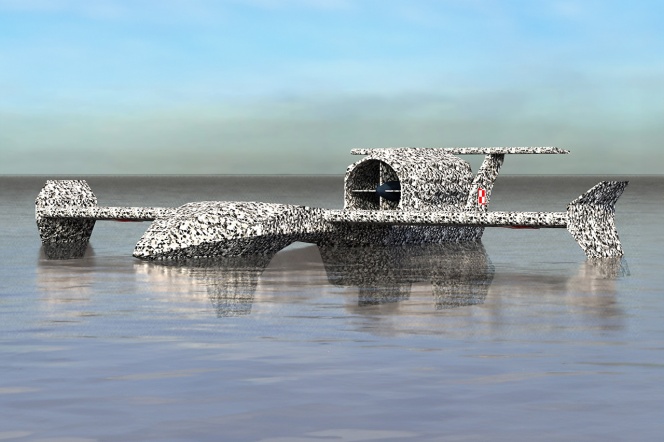Date added: 2024-01-18
The world's first small, unmanned ground-effect plane is being created at Gdańsk University of Technology

The project is being developed as part of the consortium of Gdańsk University of Technology, which is its leader, the Jarosław Dąbrowski’s Military University of Technology, and the Air Force Institute of Technology. Several million zlotys were raised for its development. The project is implemented as part of the defense program financed by the National Center for Research and Development.
Ekranoplan like pelican wings
The unmanned surface and air platform type USV-UAV-WIG (Unmanned Surface Vehicle - Unmanned Arial Vehicle - Wing in Ground Effect) is a type of vehicle that combines the features of an aircraft and a surface vehicle. It moves using the near-surface effect. This phenomenon, in short, consists in increasing the lift force of an aircraft moving at a low height above the ground or water (the assumed height is equal to half the wing span). The wings thus produce more lift than when flying at a higher altitude. This is primarily due to the significant increase in the swirl area generated by the airfoil. "Aerodynamicists" and "hydrodynamicists" can easily describe this phenomenon analytically. The surface effect is used, for example, by birds such as herons, cranes and pelicans, which fly just above the water surface in search of food, rarely and "lazily" moving their wings.
The near-surface effect or ground-effect was discovered already during World War I, but it was only in the 1920s that it began to be studied. In the 1930s, the first tests with vehicles using this phenomenon were carried out in Finland and Sweden. In the early 1960s, several experimental ground-effect planes were built in the USSR, which were used for tests and research on the near-surface effect. The first flight of a manned Ekranoplan took place in 1966.
Increasing the effectiveness of rapid reaction forces
The rapidly changing geopolitical situation in the world and in the Baltic Sea region requires changes to security systems at the strategic and tactical level. Due to the unpredictability of sudden events, especially events leading to threats (enabling qualitative and quantitative assessment of risk and safety), constant development of the capabilities of rapid reaction forces in maritime areas is necessary. Modern maritime defense tactics require multi-functional ships and maritime platforms, including surface and underwater manned units and unmanned platforms. Unmanned platforms are elements of rapid reaction force systems at sea. One of such platforms is the Ekranoplan, which is currently being created.
– The main goal of the project is to create a solution, a platform that will contribute to increasing state security – explains the project manager, Prof. Mirosław K. Gerigk from the Department of Mechanical Vehicles and Military Technologies at the Faculty of Mechanical Engineering and Shipbuilding.
– When building the prototype, we made several main assumptions – adds Marek Chodnicki, PhD, Eng., from the Department of Applied Mechanics and Biomechanics, FMEST, executive manager in the project. – First of all, the unit is to carry out designated tasks over water areas near the coastline, take off from the water, fly at a minimum height above the water surface and launch, carrying loads of a given weight.
Turboprop drive and remote control
The project will include research using advanced computer simulation methods and research on physical models of the vehicle. Based on the results obtained, a platform technology demonstrator will be created that can be tested in conditions close to real ones. The Ekranoplan prototype is to be ready in 2026 and is made of hybrid materials: primarily glass and carbon fibers with a plastic sandwich material.
The platform under construction will have a turboprop drive. It will float above the water at a height of several meters and weigh a maximum of 400 kilograms. The vehicle will be controlled remotely from the shore, the next stages of work will lead to increasing its autonomy.
Two physical prototypes of the platform will be created. Construction of the smaller one will begin this spring, and its conventional size will be two meters. The target prototype will be twice as large and will be ready for testing in 2026.

